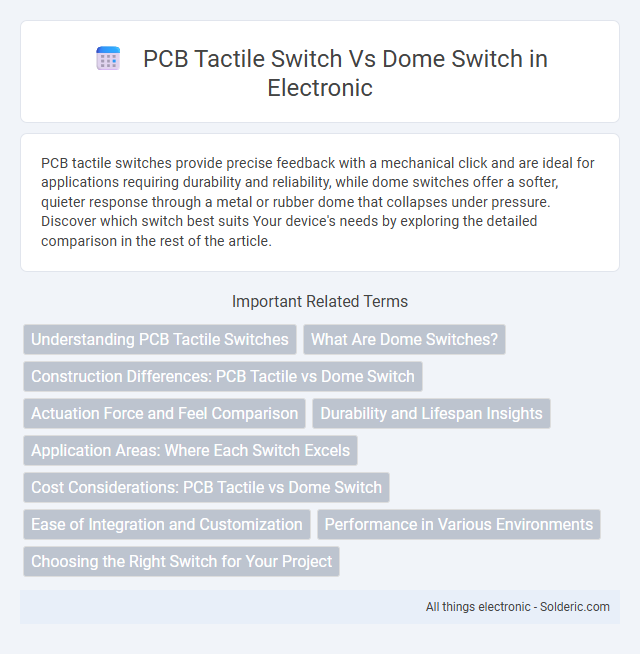PCB tactile switches provide precise feedback with a mechanical click and are ideal for applications requiring durability and reliability, while dome switches offer a softer, quieter response through a metal or rubber dome that collapses under pressure. Discover which switch best suits Your device's needs by exploring the detailed comparison in the rest of the article.
Comparison Table
| Feature | PCB Tactile Switch | Dome Switch |
|---|---|---|
| Type | Mechanical switch mounted on PCB | Conductive dome under membrane |
| Actuation | Physical press activates internal contacts | Dome collapses to complete circuit |
| Tactile Feedback | Distinct click or snap | Soft tactile pop |
| Lifespan | Up to 1 million actuations | Typically 100,000 to 1 million actuations |
| Size | Generally larger, occupies PCB space | Thin, low-profile design |
| Applications | Keyboards, industrial control panels | Remote controls, membrane keyboards |
| Cost | Higher per unit cost | Lower cost, suitable for mass production |
| Assembly | Requires PCB soldering | Integrated into membrane layers |
Understanding PCB Tactile Switches
PCB tactile switches provide precise, responsive feedback through a mechanical mechanism that completes an electrical circuit when pressed, making them ideal for user interfaces requiring reliability and durability. These switches feature a small, robust design with metal domes or rubber actuators mounted directly on printed circuit boards (PCBs), enabling efficient integration and stable contact under repeated use. The tactile response and compact size offer distinct advantages over dome switches, which rely primarily on membrane layers and typically deliver less pronounced feedback and shorter lifecycle performance.
What Are Dome Switches?
Dome switches are tactile input devices commonly used in keyboards and control panels, featuring a flexible metal dome that collapses to complete an electrical circuit when pressed. These switches provide a consistent tactile feedback and audible click, enhancing user experience by confirming button activation. Your choice between PCB tactile switches and dome switches depends on the desired durability, tactile response, and cost-effectiveness for your electronic device.
Construction Differences: PCB Tactile vs Dome Switch
PCB tactile switches feature a rigid plastic or metal actuator that directly presses down on a mechanical contact, providing a crisp, tactile feedback through physical movement. Dome switches use a flexible metal dome that collapses when pressed, closing the circuit and providing a softer, quieter tactile response with less mechanical complexity. The structural difference impacts durability, actuation force, and tactile sensation, with PCB tactile switches generally offering higher reliability and distinct feedback compared to the subtle feel of dome switches.
Actuation Force and Feel Comparison
PCB tactile switches typically have a lower actuation force ranging from 50 to 180 grams, providing a distinct, crisp click feedback ideal for precise applications. Dome switches generally require a higher actuation force of 160 to 250 grams and offer a softer, less tactile feel due to their rubber or metal dome design. The tactile switch's clicky sensation ensures better user feedback, while dome switches provide quieter operation with a smoother keypress.
Durability and Lifespan Insights
PCB tactile switches offer higher durability with mechanical lifespans typically ranging from 1 to 5 million actuations, making them suitable for applications requiring long-term reliable performance. Dome switches, often made from metal or polymer domes, generally have shorter lifespans around 200,000 to 1 million actuations but provide excellent tactile feedback and low actuation force. Your choice depends on whether you prioritize extended durability or enhanced tactile response in your electronic device.
Application Areas: Where Each Switch Excels
PCB tactile switches excel in electronic devices requiring precise, low-profile actuation such as remote controls, calculators, and handheld instruments, offering reliable feedback and long lifespan. Dome switches are ideal for membrane keyboards, automotive controls, and consumer appliances, where a sealed, compact design and softer tactile response enhance user experience. Your choice depends on the device's durability needs, actuation force preference, and environmental exposure.
Cost Considerations: PCB Tactile vs Dome Switch
PCB tactile switches generally incur higher costs due to their complex manufacturing process and durable mechanical components, making them ideal for applications requiring long-term reliability. Dome switches, featuring a simpler design with a metal dome providing tactile feedback, tend to be more cost-effective and suitable for budget-sensitive projects with moderate usage demands. Your choice between these two depends on balancing initial investment against expected switch lifespan and usage frequency.
Ease of Integration and Customization
PCB tactile switches offer straightforward integration with printed circuit boards through standardized mounting options, making them highly customizable in terms of size, actuation force, and travel distance. Dome switches feature a simpler design, often relying on overlay membranes and are easier to adapt for low-profile applications but provide less variability in mechanical customization. Your choice depends on whether you prioritize precise mechanical properties or thin, flexible integration for your electronic device.
Performance in Various Environments
PCB tactile switches offer precise actuation and excellent durability, making them suitable for harsh environments with exposure to dust, moisture, and temperature fluctuations. Dome switches provide consistent tactile feedback and are often preferred in consumer electronics due to their quiet operation and reliability in controlled settings. Your choice should consider the environmental conditions and required responsiveness to ensure optimal performance and longevity.
Choosing the Right Switch for Your Project
Selecting the right switch for your project involves evaluating tactile switches and dome switches based on durability, actuation force, and feedback response. PCB tactile switches offer precise mechanical feedback and longer lifespan, making them ideal for applications requiring reliability and frequent use. Dome switches provide a softer tactile feel with a lower profile, suitable for compact designs where subtle feedback is preferred.
PCB tactile switch vs dome switch Infographic

 solderic.com
solderic.com